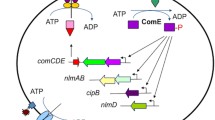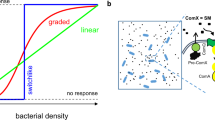Abstract
The ComX pheromone is an extracellular signaling molecule that stimulates natural competence in response to crowding in the Gram-positive bacterium Bacillus subtilis. The pheromone is formed by isoprenylation of an inactive precursor peptide, but its precise structure is not known. Here we report the structure of the ComX pheromone, showing that addition of a geranyl group to a tryptophan residue results in the formation of an unusual ring structure.


Similar content being viewed by others
References
Magnuson, R., Solomon, J. & Grossman, A.D. Cell 77, 207–216 (1994).
Ansaldi, M., Marolt, D., Stebe, T., Mandic-Mulec, I. & Dubnau, D. Mol. Microbiol. 44, 1561–1573 (2002).
Ansaldi, M. & Dubnau, D. J. Bacteriol. 186, 15–21 (2004).
Tortosa, P. et al. J. Bacteriol. 183, 451–460 (2001).
Bacon Schneider, K., Palmer, T.M. & Grossman, A.D. J. Bacteriol. 184, 410–419 (2002).
Okada, M. et al. Biosci. Biotechnol. Biochem. 68, 2374–2387 (2004).
Sakagami, Y., Yoshida, M., Isogai, A. & Suzuki, A. Science 212, 1525–1527 (1981).
Clarke, S. Annu. Rev. Biochem. 61, 355–386 (1992).
Piazza, F., Tortosa, P. & Dubnau, D. J. Bacteriol. 181, 4540–4548 (1999).
Acknowledgements
The work performed in Nagoya was supported by Grants-in-Aid for Centers of Excellence (13CE2005 and 14COEA02) and for Scientific Research (No. 16580087). The work in Newark was supported by US National Institutes of Health grant GM57720.
Author information
Authors and Affiliations
Corresponding authors
Ethics declarations
Competing interests
The authors declare no competing financial interests.
Supplementary information
Supplementary Fig. 1
1H NMR spectra of natural ComXRO-E-2 and synthetic ComXRO-E-2. (PDF 98 kb)
Supplementary Fig. 2
The DQF-COSY spectra of ComXRO-E-2. (PDF 121 kb)
Supplementary Fig. 3
The ROESY spectra of ComXRO-E-2. (PDF 84 kb)
Supplementary Fig. 4
Conformational analysis of a model of modified tryptophan 2. (PDF 52 kb)
Supplementary Table 1
1H NMR chemical shifts and coupling constants of geranyl groups and modified tryptophan residues in the natural ComXRO-E-2 pheromone and in synthetic peptides. (PDF 37 kb)
Supplementary Scheme 1
Purification scheme of the ComXRO-E-2 pheromone. (PDF 488 kb)
Supplementary Scheme 2
Synthetic scheme of ComXRO-E-2. (PDF 691 kb)
Rights and permissions
About this article
Cite this article
Okada, M., Sato, I., Cho, S. et al. Structure of the Bacillus subtilis quorum-sensing peptide pheromone ComX. Nat Chem Biol 1, 23–24 (2005). https://doi.org/10.1038/nchembio709
Received:
Accepted:
Published:
Issue Date:
DOI: https://doi.org/10.1038/nchembio709
- Springer Nature America, Inc.
This article is cited by
-
Unusual peptide-binding proteins guide pyrroloindoline alkaloid formation in crocagin biosynthesis
Nature Chemistry (2023)
-
LimF is a versatile prenyltransferase for histidine-C-geranylation on diverse non-natural substrates
Nature Catalysis (2022)
-
Thidiazuron, a phenyl-urea cytokinin, inhibits ergosterol synthesis and attenuates biofilm formation of Candida albicans
World Journal of Microbiology and Biotechnology (2022)
-
Bacterial quorum sensing in complex and dynamically changing environments
Nature Reviews Microbiology (2019)





